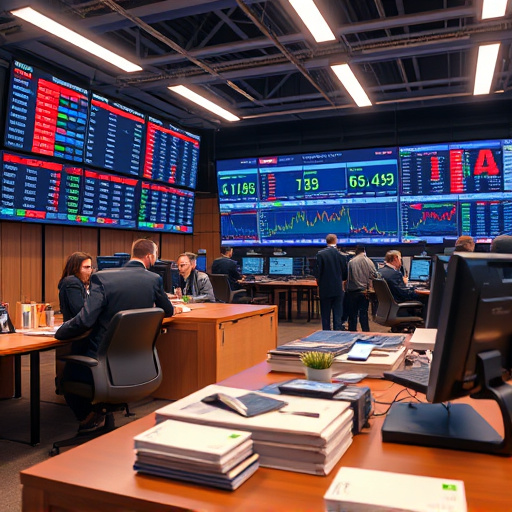Traders seeking wealth within dynamic markets rely on economic indicators and news analysis to anticipate shifts, identify trends, and make strategic decisions. By tracking metrics like inflation, employment, GDP, and interest rates, investors gain a competitive edge, enabling proactive decision-making and potential profit growth in volatile environments. Integrating technical and fundamental analysis allows traders to navigate market moves based on both economic factors and price trends, while risk management strategies and backtesting optimize performance and preserve wealth.
Unleash your trading potential by harnessing the power of economic indicators and news. In today’s dynamic market landscape, understanding how these elements drive price movements is crucial for achieving wealth within. This comprehensive guide explores essential tools like economic indicators and their impact on markets, guiding you through news events that shape trends. Learn the art of combining technical analysis with fundamental insights to identify lucrative trade setups while implementing robust risk management strategies for wealth preservation. Discover proven methods for backtesting and optimizing trading signals for maximum profitability.
- Understanding Economic Indicators: Key to Trading Success
- News Events Impact Markets: Be Ahead of the Curve
- Technical Analysis Meets Fundamental Insights
- Identifying High-Potential Trade Setups
- Risk Management Strategies for Wealth Preservation
- Backtesting and Optimizing Trading Signals
Understanding Economic Indicators: Key to Trading Success

Economic indicators are vital tools for traders seeking to optimize their strategies and unlock wealth within the market. These indicators provide insights into a country’s economic health, reflecting various aspects such as inflation rates, employment data, GDP growth, and interest rates. By closely monitoring these factors, traders can anticipate market movements and make informed decisions.
Understanding economic indicators is crucial for successful trading. It allows investors to navigate the complex landscape of global markets, identify trends, and capitalize on emerging opportunities. When combined with news events and analysis, economic indicators offer a comprehensive view, enabling traders to adapt their strategies swiftly and potentially increase their wealth within the dynamic trading environment.
News Events Impact Markets: Be Ahead of the Curve

In today’s dynamic financial landscape, news events and economic indicators play a pivotal role in shaping market trends. Being ahead of the curve when it comes to these developments can offer a significant edge for traders seeking to optimize their trades and unlock wealth within volatile markets. Timely access to crucial information allows investors to anticipate price movements, enabling them to make informed decisions that align with the market’s anticipated reaction to news releases, policy changes, or geopolitical events.
Staying abreast of economic calendars and news feeds is essential for navigating the market effectively. Key indicators like GDP growth rates, employment data, interest rate decisions, and inflation reports can trigger substantial price swings across various asset classes. By integrating these factors into their trading strategies, investors can position themselves to capitalize on emerging trends or mitigate potential risks, ultimately fostering a path toward sustained wealth accumulation.
Technical Analysis Meets Fundamental Insights

Technical analysis and fundamental insights are powerful tools when combined, offering traders an edge in the market. By merging these two strategies, investors can gain a comprehensive understanding of market trends and make more informed decisions. Fundamental analysis provides the underlying strength of an economy or a specific industry, revealing intrinsic value and potential. Meanwhile, technical analysis employs historical price and volume data to identify patterns and trends, acting as a signal for entry and exit points.
This fusion allows traders to optimize their strategies, especially when economic indicators and news events are considered. For instance, a trader can use fundamental insights to anticipate market moves based on policy changes or economic reports, then use technical analysis to time their trades accordingly. This approach, focused on wealth within the market’s pulse, ensures that decisions are not just reactive but proactive, potentially leading to more lucrative outcomes.
Identifying High-Potential Trade Setups

In the dynamic landscape of trading, identifying high-potential trade setups is akin to unearthing hidden treasures in a vast market tapestry. Economic indicators and news play a pivotal role in this quest for wealth within. By closely monitoring key metrics like interest rates, inflation data, GDP growth, and geopolitical events, traders can anticipate market shifts and capitalize on emerging trends. For instance, a surge in consumer confidence, indicated by rising consumer sentiment indices, might signal increased spending, boosting stocks in the retail sector.
These indicators serve as compasses guiding investors toward promising opportunities. News headlines, both positive and negative, can quickly alter market dynamics, creating short-term volatility that savvy traders embrace. A surprise interest rate cut by a central bank can fuel a rally in riskier assets, while geopolitical tensions escalating could prompt a flight to safer havens like gold or the US dollar. Staying informed and responsive to these developments allows traders to position themselves strategically, aiming to capture significant gains within rapidly evolving market conditions.
Risk Management Strategies for Wealth Preservation

In the volatile world of trading, preserving wealth is as crucial as growing it. Effective risk management strategies are essential tools for achieving this balance. One of the key aspects is setting appropriate position sizes. Traders should aim to allocate only a small percentage of their total capital to each trade, diversifying their portfolio to mitigate risks associated with individual investments. This approach ensures that even if some trades don’t go as planned, the overall wealth remains within manageable boundaries.
Additionally, stop-loss orders play a vital role in wealth preservation. These orders automatically close positions when they reach a certain loss threshold, limiting potential downside risk. Traders should strategically place stop-loss orders based on their risk tolerance and market volatility, allowing them to walk away from losing positions without incurring substantial losses. By combining thoughtful position sizing and stop-loss orders, traders can navigate market uncertainties while safeguarding their wealth within manageable limits.
Backtesting and Optimizing Trading Signals

Backtesting is a powerful tool for traders aiming to optimize their strategies and unearth consistent winning signals. By simulating trades based on historical data and economic indicators, traders can assess the potential profitability and risk of a given approach. This process involves feeding past market data into a trading model to evaluate its performance across various scenarios. For instance, backtesting might reveal that combining technical analysis with specific economic indicators yields robust entry and exit points for trades, ultimately leading to wealth within.
Optimizing trading signals is an iterative process that requires constant refinement. Traders can use backtesting to identify the most reliable indicators and their ideal combinations. Once a promising strategy emerges, further optimization can fine-tune parameters for maximum effectiveness. This ensures that when market conditions change, the trading signals remain relevant and profitable. By harnessing the insights from backtesting, traders can make informed decisions, adapt to dynamic markets, and consistently work towards growing their wealth within.
By harnessing the power of economic indicators, staying informed through market news, and combining these with technical analysis, traders can make more informed decisions. Incorporating fundamental insights allows for identifying high-potential trade setups while effective risk management strategies preserve wealth within. Backtesting trading signals further optimizes performance, enabling investors to achieve their financial goals with greater confidence and success.
